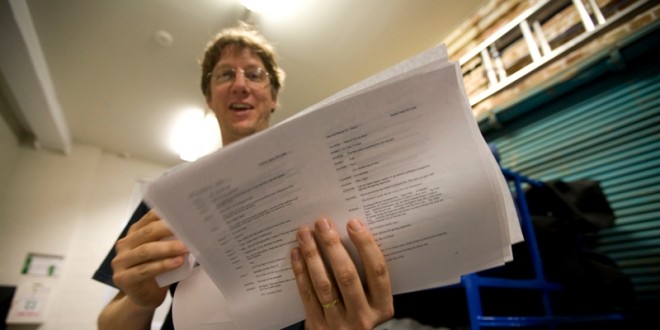Over the years I have also been heavily involved in theatre, not so much as a viewer, but as a maker. Although I enjoy watching theatre, I'm not inclined to spend my money to be an audience member. I have not been particularly interested in acting - I'm not very good at portraying others, being in their shoes or imagining how they might behave.
My interest is primarily in putting the pieces together to tell stories. The meaning is in the making, not the receiving and the process of defining that meaning has strong connections to my process as a composer. Much of the theatrical productions I have undertaken have fallen within the domain of physical or total theatre, where music, lights, text and body combine on equal terms to create the piece. In some instances, songs have been performed to juxtapose and comment on the text, some have been text based with underscores and movement, others have had no text at all. I have not involved myself with "musical theatre" as a composer, and I find theatre without musical underscore somewhat dry.
Generally, I am involved quite early in the production, being brought into discussions with the directors around the "treatment" of individual scenes and the production as a whole. What will the whole hour sound like, will it be loud, cold, dynamic, subtle, epic, past or future? In most instances the music will be developed with MIDI and computer virtual instruments and pre-recorded. This has as much to do with budgetary constraints as anything, although the music often evolves during the production phase, which also makes it hard to re-record many musicians.
At the same time the lighting director and choreographer will be present, looking at colours and movement, dark, light and focus. Will the cast and audience interact physically? Should the audience be immersed in the experience or look through a window to the world on stage?
In these initial meetings I begin to get a feel for styles and instruments, what sounds might suit characters and events.
The magic for me begins when I first see the blocking. Blocking is the process of placing the actors physically around the stage. Where they move, the direction they face, the objects they touch as their lines are delivered. At this point the director and the actors are discussing the meaning of every line. The intention of each character is defined - are they speaking truth or deceiving, what do they know that they are not saying, what are their hopes and fears. On top of that, what do we want the audience to be aware of. Are they taking the perspective of one or other character? Are they dispassionate observers? What does the audience know that the characters do not? In what way do we want to surprise them? How should they feel.
Everything that happens in the environment must serve that purpose - lights, sound, music, space, text, action.
For me this is a fascinating process and something that never happens in "real life". In "real life" everything is a mystery. There is never a single way of looking at an interaction. We don't get to analyse the conversation and discover the intent, to go back and play it again until it is understood.
After observing a blocking session I will create demos and bring in music for underscore or movement. Typically with Zen Zen Zo we will watch the block through, then play in the demo music on the next run. At this point I get to see how the music affects the performance of the actors. If I got it right, everything seems to get bigger. The actors are more intense, the words cut deeper. It is not uncommon to get "choked up", both me and they.
Sometimes the music I have brought in surprises the cast and director. Maybe I have missed the feeling despite the briefings and rehearsals or expressed it in an unusual way. Sometimes this results in a "back to the drawing board" but sometimes, the really precious times, it just works and no-one seems able to explain it.
The theatre process has its parallels in the studio, especially when lyrics are involved, but also as instruments and parts are laid in. Then there are new questions to ask. What is the meaning of each line? Is it direct or ironic, are you singing for yourself, or a lover or friend? Is it just for fun or is the message the king? Should the guitar reinforce the melody or balance or oppose it?
Central to both these experiences is the opportunity to discuss emotion and social intent. This is cognitive empathic process in action. This is Virtual Heart building.
Related Posts
- Video Complexities: People are much more complex than I thought possible.
- Exposure: Exposing the self to scrutiny.
- Meaning Making: Meaning must surely be found somewhere?
- Current practice: I am now teaching music and sound production full time at Tertiary level and continue to work compose for collaborative projects.
- Speaking in Pictures: Story telling with text sometimes requires the services of actors of different kinds.
- Un-words and art-i-facts: Web-based, non-linear, no paper version, multimedia, reflective of thought process ... These are concepts guaranteed to raise questions in the hearts of university bureaucracies.
- The Safer Intimacy: Some forms of intimate communication are "safer" than others and facilitate a greater degree of emotional freedom.
